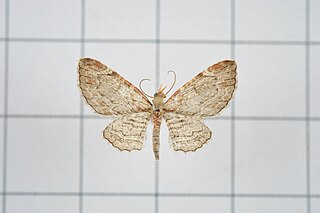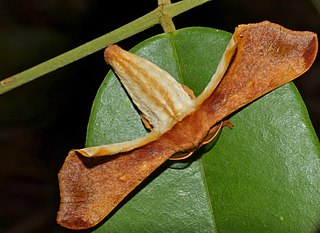
Hemonia is a genus of moths in the family Erebidae first described by Francis Walker in 1863. They are found only in Sri Lanka and Borneo.

Chadisra bipars is a moth of the family Notodontidae. It was described by Francis Walker in 1862 and is found in the Indomalayan realm.

Probithia exclusa is a moth of the family Geometridae. It is found in the north-eastern Himalaya, Sri Lanka, the Philippines, Sulawesi and Sundaland.

Planotortrix excessana, the greenheaded leafroller, is a moth of the family Tortricidae. It is native to New Zealand and is an introduced species in Hawaii. It is extremely variable in appearance and feeds on many native and introduced species. It is regarded as a pest of some agricultural and forestry crops.

Tiracola plagiata, the cacao armyworm, is a species of moth in the family Noctuidae. The species was first described by Francis Walker in 1857. It is found from south-east Asia, southern India, Sri Lanka, Myanmar to the South Pacific Islands, including the northern two-thirds of Australia.

Negeta contrariata is a moth in the family Nolidae first described by Francis Walker in 1862. It is found from the Indo-Australian tropics of India, Sri Lanka, Borneo east to Australia (Queensland) and the Bismarck Archipelago.

Scirpophaga incertulas, the yellow stem borer or rice yellow stem borer, is a species of moth of the family Crambidae. It was described by Francis Walker in 1863. It is found in Afghanistan, Nepal, north-eastern India, Sri Lanka, Bangladesh, Myanmar, Vietnam, Thailand, Malaysia, Singapore, Sumatra, Java, Borneo, Sumba, Sulawesi, the Philippines, Taiwan, China and Japan.

Teulisna tumida is a species of moth of the family Erebidae first described by Francis Walker in 1862. It is found in Borneo, Sumatra, China, India, Sri Lanka, Thailand and Taiwan.

Gesonia obeditalis is a species of moth of the family Noctuidae first described by Francis Walker in 1859. It is found from eastern Africa, the Seychelles, the Maldives and the Oriental tropics of India, Myanmar, Sri Lanka east to the Philippines, the Sula Islands and Australia. The adult moth has brown wings with a scalloped dark brown band near the margin. The hindwings are similar in pattern to the forewings but are a paler shade of brown.

Eupithecia costalis is a moth in the family Geometridae first described by Francis Walker in 1863. It is widespread in the tropical and subtropical lowland regions of east and south-east Asia, from Taiwan to India, Sri Lanka Borneo, to Hong Kong.
Ziridava xylinaria, the indistinct carpet, is a moth in the family Geometridae. The species was first described by Francis Walker in 1863. It is found in Sri Lanka, India, Hong Kong and on Peninsular Malaysia, Borneo, Java and possibly the Philippines and Sulawesi.
Gymnoscelis imparatalis, the flower-looper moth, is a moth in the family Geometridae. It is found from the Indo-Australian tropics of India, Sri Lanka, east to the Society Islands and the Marquesas Archipelago. The habitat consists of both lowland and montane ecosystems.
Carbia pulchrilinea is a moth in the family Geometridae. The species was first described by Francis Walker in 1866. It is found in the Indian subregion, Sri Lanka and New Guinea, as well as on Borneo, the Mentawai Islands and the Bismarck Archipelago. The species is found from lowlands to the upper montane forest zone.
Narosodes punctana is a moth of the family Erebidae. It was described by Francis Walker in 1863. It is found in Sri Lanka and India and on Borneo.

Gunda ochracea is a species of moth in the family Bombycidae. It was described by Francis Walker in 1862. It is found in the Indian subregion and from South-east Asia to Sumatra, Borneo and the Philippines. The habitat consists of various lowland forest types.
Charltona desistalis is a moth in the family Crambidae. It was described by Francis Walker in 1863. It is found in Sri Lanka.
Surattha invectalis is a moth in the family Crambidae. It was described by Francis Walker in 1863. It is found in Sri Lanka, India, Java, Indonesia, Myanmar, and Kenya.
Imma pardalina is a moth in the family Immidae. It was described by Francis Walker in 1863. It is found on Borneo and in Malaysia (Selangor) and Singapore.
Rivula bioculalis is a moth of the family Erebidae first described by Frederic Moore in 1877. It is found in Sri Lanka, the Andaman Islands, the Indian subregion, Taiwan, Thailand and Borneo.
Hypena mandatalis, is a moth of the family Erebidae first described by Francis Walker in 1859. It is found in the Indian subregion, Pakistan, Sri Lanka, Borneo, Sulawesi and Australia.











